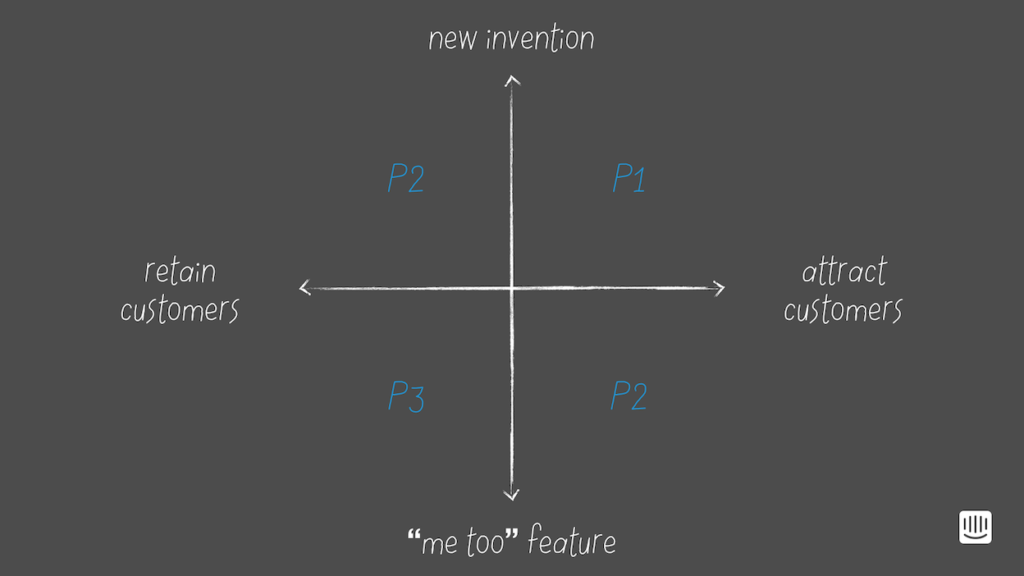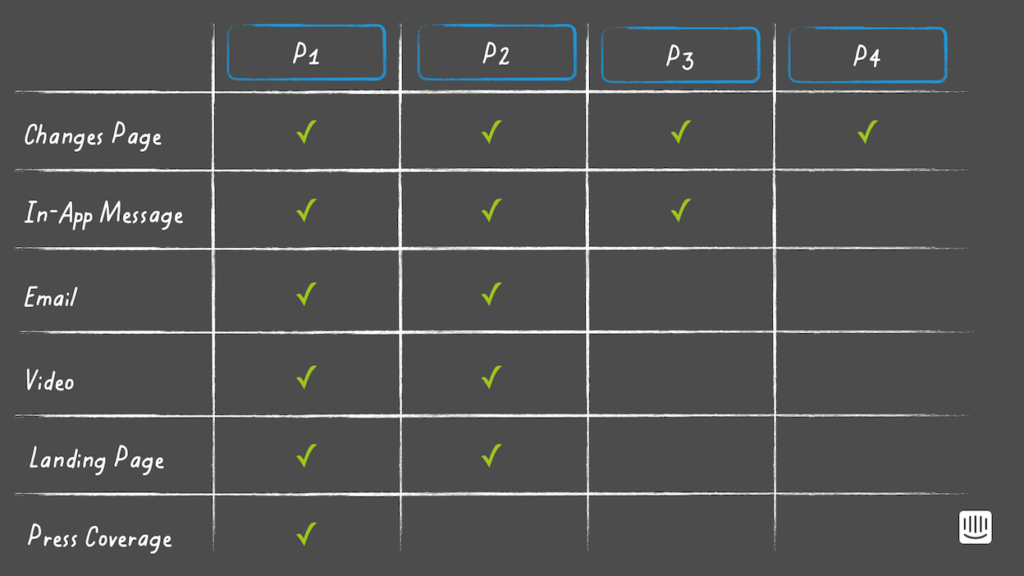Hi, I’m James. Thanks for checking out Building Momentum: a newsletter to help startup founders and marketers accelerate SaaS growth through product marketing.
Announcing new features can be the bane of a product marketer’s work life.
Product can build something autonomously, let the PMM know when it’s going to be shipped, and expect it to be announced through the usual channels.
And, well, that’s probably fine. But it’s not great.
It’s an example of PMM as a conveyor belt team.
Conveyor belt marketing teams just take whatever comes down the pipe – like product features, new marketing campaign ideas, messaging, collateral requests – and just run with it.
Ideas, campaigns, launches are just put into the world with best intentions, but weak discipline as to whether they will actually have an impact.
And new tactics, new projects are always coming down the assembly line (from leadership, from product or sales teams) – so any mistakes and missteps are never long-lived enough. We’ll do better with the next one!
Don’t be a “conveyor belt” team
Teams can take many different approaches to feature launches. The most common in SaaS is based on Intercom’s feature prioritization matrix
And this is fine, but it lacks any real strategy. Deliverables are turned into tasks, checked off in a to-do manager for a feeling of satisfaction – but a lack of impact.
What if we reimagined how to ensure feature releases make a real impact on our business, our customers, and their outcomes?
In this post:
The five A’s of successful feature releases
We all want our feature releases to have impact – ideally with the minimum work required. But to get there, we need to build new concepts to think about the intended outcomes, not just the planned work.
See what you think below – could you use these four concepts to get more efficient and effective feature launch results?
Audience
The audience you promote new features to probably has a bigger end-result on performance than whatever it is you’re actually shipping.
Just as with defining the ideal customer for your product, we need to niche down. Don’t just blast the email and show the in-app notification to all customers.
Instead, be selective: who needs to know about the feature?
For example:
- Customers that have shown interest or meet a particularly niche segment
- Show to all existing customers, only those who joined between specific dates, or only those with a specific registration date
- Send emails with different copy and action depending on the user persona
A good tip is to think about the anti-audience: what types of customers will NOT be interested in what you’re announcing?
Awareness
Every feature release checklist in the world has:
- In-app notification
- Social
… as standard for every top priority feature. But does it actually make sense to do these for every release? Probably not. We keep these in because we think it’s a good idea to make customers informed of new features, even if they’re not tied to their particular usecase or challenges. More product features is always a good thing, right?
I think it can do the opposite: too much noise trains your customers to ignore feature releases. In-app notifications get swiped away instantly without a second thought. And if they’re luckily enough to be opened in the first place, emails are skimmed and archived immediately.
Instead, think about how we can help customers become aware of new features at the right time.
For example:
- Show in-app notifications to customers when they take a particular in-app action (e.g. visit a new page, or click a specific button)
- Send behavioral emails when it makes sense, not just at a specific point in time because the functionality is now available
Always ask whether announcing the feature now will have the best impact, or if there’s a more timely approach.
Action
What’s the specific action we want customers to take with our feature release?
Tip: ‘Read the announcement blog post’ is never the best use of your customer’s attention.
Sometimes we’ll want to guide customers to enable a setting, setup a new feature from scratch, or convince their boss to purchase an add-on. Sometimes, it’s just an FYI – “there’s a new thing, thought ya might be interested.”
This largely depends on everything above – the audience, the channels you’re using to build awareness, and the affinity you’re chasing.
For top-tier customers, we wouldn’t send an email that asks an admin to just ‘switch on’ a feature that uses machine learning to do stuff. We’d use an explainer and ask for a meeting to be booked to showcase how the new functionality can lead to X% better outcomes.
Considering the most effective next step, and enabling teams across customer success, support, sales, and product is a surefire way to build an efficient customer/user journey.
Affinity
This is getting deep: what do we want customers to feel when we announce features?
A good exercise is to work with your customer success team and start with first principles. For each customer tier, what should their experience entail? What role do feature launches play in their evaluation, usage, and renewal/expansion decisions of your product?
For example:
- Top-tier customers are focused on processes and avoiding hiccups, so we shouldn’t announce new features to them autonomously. New releases should be batched up, and presented by a customer success manager who can tailor them to the client’s specific use case.
- Self-service, low-touch customers are mostly interested in ease of use for core capabilities, and improvements to these should be proactively promoted.
- Customers with the potential to expand need to feel confident in our product innovation velocity – let’s send them everything, as soon as it’s available.
This then allows you to execute more impactful launch strategies that contribute to a customer’s perception of your company.
Accountability
The holy grail of PMs and PMMs is to measure feature releases against business or customer outcomes, and iterate until those goals are achieved.
In reality, it’s very rare. It can take a lot to reorient a business around a different approach to building product, and it’s difficult to showcase incrementality (whether PMM work has had an improvement against the baseline, or not).
In the meantime, we can all start somewhere.
For certain features where it makes sense, we should guesstimate some goals that show whether our feature release met the specifics we’ve outlined above – plus any measurable business or customer outcomes.
For example, we might report on:
- Audience: How many targeted customers were successfully reached in the first four weeks of a feature release
- Awareness: How many customers engaged with feature release comms
- Action: How many customers took the intended action (e.g. activated a feature)
- Affinity: Positive/negative feedback via support and success teams
- Accountability: Whether business/customer outcomes have been met
Don’t wait for a full strategy: get started today
When I talk to product marketers, often the biggest barrier to more effective feature releases is waiting for a bigger strategy (either from their leadership, or their own to-do list).
But you don’t need to think through the whole strategy first. You don’t need to build the perfect matrix, think about the never-ending list of distribution and marketing channels at your potential disposal, or drag out sign-off from ten different stakeholders.
Just start with your next feature:
- What’s the best audience for this – and what’s the anti-audience?
- What channels make the most sense for this, and when would be best for customers to become aware?
- What’s the overall intended action, but what makes sense as the next step in the journey?
- What should our audience/customer segments think and feel about our product with this announcement?
- What makes sense to measure, both as a yardstick for the announcement performance and as a proxy for feature incrementality?
Spend a few minutes thinking about these, write the answers down, then build from there. Have fun!
Thanks for reading! Let me know what you thought – find me on Twitter and LinkedIn.
P.S. If you’ve found value in Building Momentum, could you buy me a coffee? Here’s my tip jar – any support is gratefully appreciated!
P.P.S: If you enjoyed this post, will you share Building Momentum with your network?






